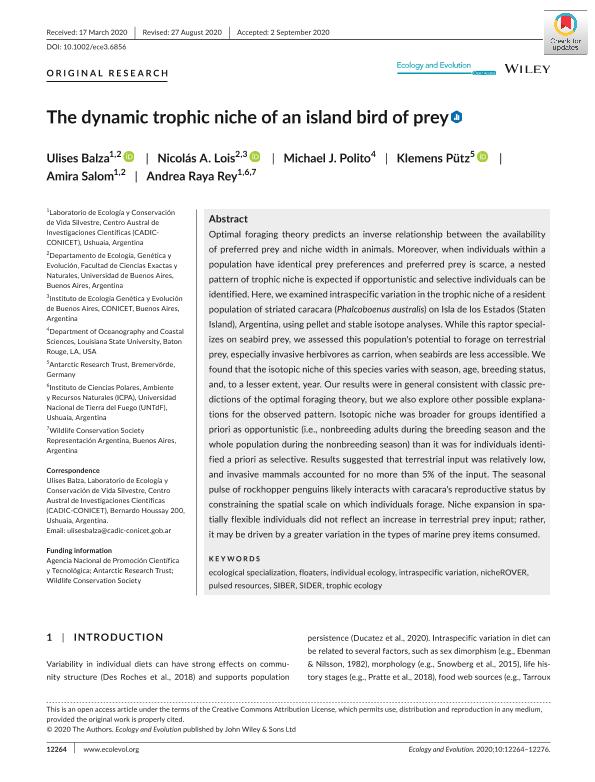Mostrar el registro sencillo del ítem
dc.contributor.author
Balza, Ulises

dc.contributor.author
Lois, Nicolás Alejandro

dc.contributor.author
Polito, Michael J.
dc.contributor.author
Pütz, Klemens
dc.contributor.author
Salom, Amira

dc.contributor.author
Raya Rey, Andrea Nélida

dc.date.available
2022-12-12T16:35:30Z
dc.date.issued
2020-10
dc.identifier.citation
Balza, Ulises; Lois, Nicolás Alejandro; Polito, Michael J.; Pütz, Klemens; Salom, Amira; et al.; The dynamic trophic niche of an island bird of prey; John Wiley & Sons Ltd; Ecology and Evolution; 10; 21; 10-2020; 12264-12276
dc.identifier.issn
2045-7758
dc.identifier.uri
http://hdl.handle.net/11336/180816
dc.description.abstract
Optimal foraging theory predicts an inverse relationship between the availability of preferred prey and niche width in animals. Moreover, when individuals within a population have identical prey preferences and preferred prey is scarce, a nested pattern of trophic niche is expected if opportunistic and selective individuals can be identified. Here, we examined intraspecific variation in the trophic niche of a resident population of striated caracara (Phalcoboenus australis) on Isla de los Estados (Staten Island), Argentina, using pellet and stable isotope analyses. While this raptor specializes on seabird prey, we assessed this population's potential to forage on terrestrial prey, especially invasive herbivores as carrion, when seabirds are less accessible. We found that the isotopic niche of this species varies with season, age, breeding status, and, to a lesser extent, year. Our results were in general consistent with classic predictions of the optimal foraging theory, but we also explore other possible explanations for the observed pattern. Isotopic niche was broader for groups identified a priori as opportunistic (i.e., nonbreeding adults during the breeding season and the whole population during the nonbreeding season) than it was for individuals identified a priori as selective. Results suggested that terrestrial input was relatively low, and invasive mammals accounted for no more than 5% of the input. The seasonal pulse of rockhopper penguins likely interacts with caracara's reproductive status by constraining the spatial scale on which individuals forage. Niche expansion in spatially flexible individuals did not reflect an increase in terrestrial prey input; rather, it may be driven by a greater variation in the types of marine prey items consumed.
dc.format
application/pdf
dc.language.iso
eng
dc.publisher
John Wiley & Sons Ltd

dc.rights
info:eu-repo/semantics/openAccess
dc.rights.uri
https://creativecommons.org/licenses/by/2.5/ar/
dc.subject
ECOLOGICAL SPECIALIZATION
dc.subject
FLOATERS
dc.subject
INDIVIDUAL ECOLOGY
dc.subject
INTRASPECIFIC VARIATION
dc.subject
NICHEROVER
dc.subject
PULSED RESOURCES
dc.subject
SIBER
dc.subject
SIDER
dc.subject
TROPHIC ECOLOGY
dc.subject.classification
Ecología

dc.subject.classification
Ciencias Biológicas

dc.subject.classification
CIENCIAS NATURALES Y EXACTAS

dc.title
The dynamic trophic niche of an island bird of prey
dc.type
info:eu-repo/semantics/article
dc.type
info:ar-repo/semantics/artículo
dc.type
info:eu-repo/semantics/publishedVersion
dc.date.updated
2021-09-07T18:23:54Z
dc.journal.volume
10
dc.journal.number
21
dc.journal.pagination
12264-12276
dc.journal.pais
Reino Unido

dc.description.fil
Fil: Balza, Ulises. Consejo Nacional de Investigaciones Científicas y Técnicas. Centro Austral de Investigaciones Científicas; Argentina
dc.description.fil
Fil: Lois, Nicolás Alejandro. Universidad de Buenos Aires. Facultad de Ciencias Exactas y Naturales. Departamento de Ecología, Genética y Evolución; Argentina. Consejo Nacional de Investigaciones Científicas y Técnicas. Oficina de Coordinación Administrativa Ciudad Universitaria. Instituto de Ecología, Genética y Evolución de Buenos Aires. Universidad de Buenos Aires. Facultad de Ciencias Exactas y Naturales. Instituto de Ecología, Genética y Evolución de Buenos Aires; Argentina
dc.description.fil
Fil: Polito, Michael J.. State University of Louisiana; Estados Unidos
dc.description.fil
Fil: Pütz, Klemens. Antarctic Research Trust; Alemania
dc.description.fil
Fil: Salom, Amira. Consejo Nacional de Investigaciones Científicas y Técnicas. Centro Austral de Investigaciones Científicas; Argentina
dc.description.fil
Fil: Raya Rey, Andrea Nélida. Consejo Nacional de Investigaciones Científicas y Técnicas. Centro Austral de Investigaciones Científicas; Argentina. Wildlife Conservation Society; Estados Unidos. Universidad Nacional de Tierra del Fuego, Antártida e Islas del Atlántico Sur. Instituto de Ciencias Polares, Ambientales y Recursos Naturales; Argentina
dc.journal.title
Ecology and Evolution
dc.relation.alternativeid
info:eu-repo/semantics/altIdentifier/url/https://onlinelibrary.wiley.com/doi/10.1002/ece3.6856
dc.relation.alternativeid
info:eu-repo/semantics/altIdentifier/doi/http://dx.doi.org/10.1002/ece3.6856
Archivos asociados
